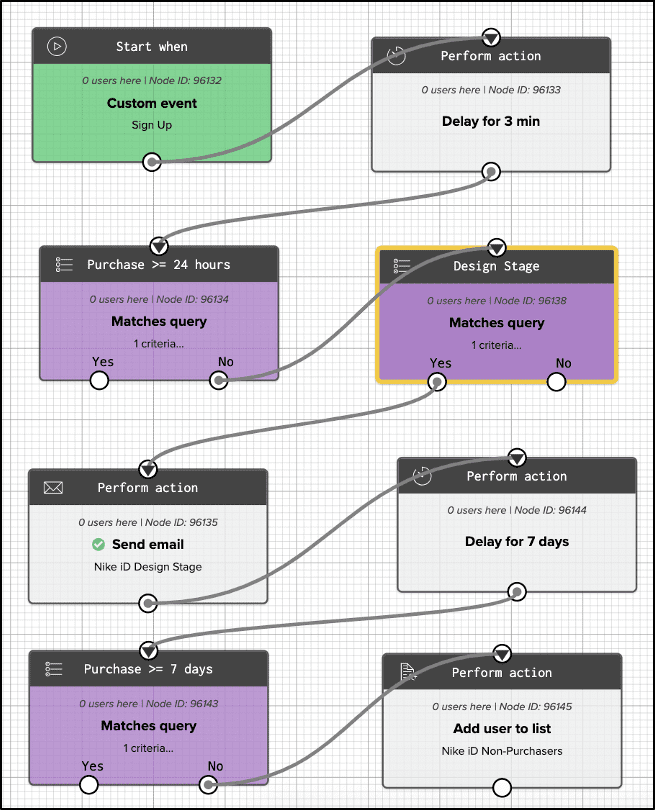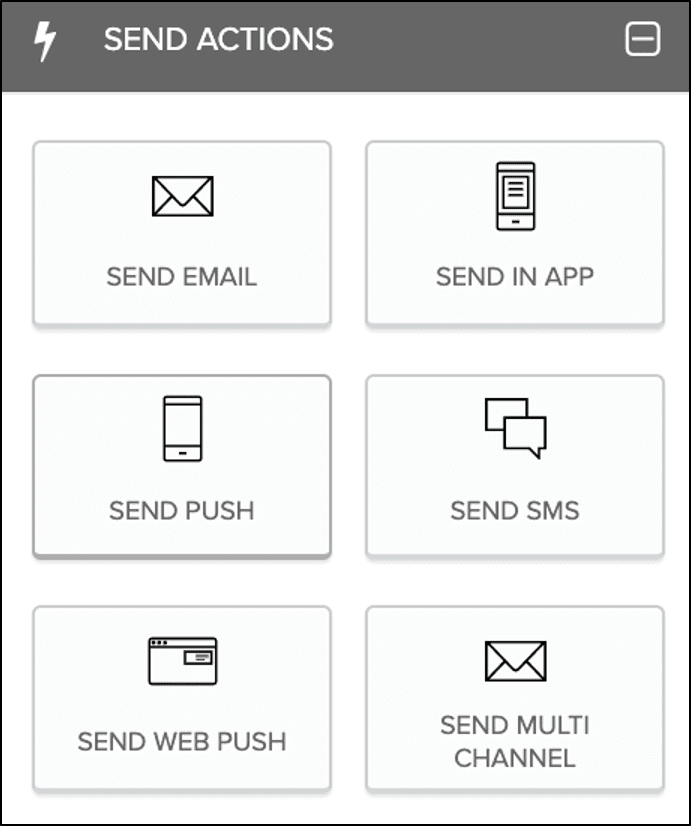Last week, we debuted our Personalization Playbook on Workflow Building, as part of our Pillars of Personalization series. In this playbook, we discuss the four building blocks of a successful messaging workflow, and how our customers like bloomon put this methodology into practice.
But one guide is not nearly enough to exhaust this topic, so we went straight to our experts to give you even more insights.
In this latest installment of “Ask an Iterator,” we ask Rebecca Chow, Senior Customer Success Manager, to dive into the finer details of workflow building so you can walk away with the confidence to build an amazing cross-channel campaign.
Ask an Iterator: Rebecca Chow


Rebecca Chow has been at Iterable for over three years, and she holds over a decade of experience in customer success and technical account management.
(And if you thought she was a heavyweight in her profession, you should know that she’s also a competitive Olympic weightlifter!)
Rebecca is ready to pump your workflows up, so let’s jump right in!
1. Let’s get everyone on the same page. How do you define a workflow?
Workflows guide your customers through different milestones of their lifecycle from the initial touchpoint (activation through an onboarding series), learning more about your products or services (nurture and engagement), to becoming loyal customers and fans (reactivation through referrals, repeat purchase, and upsells).
In Iterable, you can customize workflows in multiple ways to send users along certain paths and send personalized and dynamic messages based on their interactions with your company.


Messaging workflows let customers choose their own adventures.
2. What should I do before I start building a messaging workflow?
I would recommend whiteboarding what the customer lifecycle should look like from your customer’s perspective from beginning to end, otherwise known as lifecycle mapping. Establish your end goal of the workflow by asking, “What do you want to achieve with this workflow?”
Then, define your audience, whether that’s prospects, new customers, existing customers, etc. Next, decide on what would be the action that the user takes to enter the workflow. Some examples could be when a user signs, fills out a form or makes a purchase.
After, draw out the steps that you would want to happen before sending the message to the user. For example, do you want to filter anyone in or out of the workflow or add a delay of a few hours and check to see if the user’s activity changed before sending the message?
Determine what you’ll be using to measure as success for your end goal, whether that is turning prospects into customers or higher conversions, for example.
3. What are the elements that make a successful workflow?
I believe that the elements that make a successful workflow include:
- A starting point of when the user will enter the flow. The message should be relevant and timely to your customer’s interactions with your organization.
- Defining the steps that the user must take before sending the message to ensure that you’re targeting the right audience, sending in a timely manner, and populating personalized dynamic content within the message.
- An end goal for the user to reach within the workflow.
- Tracking and monitoring metrics to measure the success of the workflow.
- Optimizing the workflow on improving overall customer experience based on the above metrics.
4. How can I expand a single message into a multi-touch series?
Instead of just sending a single message, you can expand the workflow into a series of messages to your customers. With a welcome series, you can expand the first message “welcoming” your customers to your company by sending a series of messages, separated by 1-3 days each, showing them how to use your product or service or even guide them through your mobile app.
If the customer signed up but has not done any other action, nudge them to do so. In a workflow, after the first message is sent, you can wait a day and then add a Filter node to check if the user has taken the specified action. If not, send the user another message to nudge them, like “create your first task” or “which genre or category interests you?”, which can help with progressive profiling and collecting more info about your user.
5. What’s the best way to implement progressive profiling?
Determine what information you would like to know about your customers that’s not readily available based on their interactions with your site. Prioritize the questions you’d like to ask and limit to only a few over time. Also, if you have a form on your site, track where they left off on filling it out.
From there, trigger the workflow when a user signs up or abandons a form on the site. Within the email, ask one question to the customer and let them select the answer by clicking on their preference (e.g. Yes/No, clothes/shoes, browsing/buying).
Upon clicking the link, you can direct the user to a form to fill out, providing more info about them. Some examples include live polling, surveys, and seasonal profiling when asking users to update their info.
6. What’s the best time to send messages and how long should the delays be in between messages? How should timing/frequency change based on campaign type?
The delays between messages should depend on the type of workflow series. I would recommend A/B testing different durations of delays between messages to first establish a baseline and then, determine which duration works best.
Also, review if you’re sending a message on the same day as when the user would receive a message from the workflow. We do not want to overwhelm your customers with too many messages in one day or within a week.
7. What are the basic campaign workflows every marketer should have?
The basic campaign workflows every marketer should have are the following (if applicable):
- Welcome/Onboarding: Introduces and guides your new users to your organization/company and how to get started.
- Abandonment: The user may have left an item in their cart, browsed a particular item or started filling out a form but never finished. From these touchpoints, you can nudge the user to complete their purchase or form.
- Purchase: Based on a user’s previous purchase, you could ask for feedback or recommend other related items, or they could become a repeat purchaser.
- Re-engagement. These are for users who were previously engaged with your company but then have not opened or clicked on an email, have not made a recent purchase, or canceled. The goal here would be to win back these customers by showing them the benefits of your products/services and what they could be missing out on.
8. What are more advanced or less commonly used workflows that can uplevel your marketing strategy?
More advanced or less commonly used workflows to uplevel your marketing strategy can include:
- Upsell/Add-ons: add-on products or items that would go well with the item added to the cart or with the purchase.
- Loyalty/Rewards: incentives for being a long-time customer or a repeat purchaser.
- Recommendations: based on previous user’s purchase history or browsing activity.
- Product Feedback: send after the user has made a purchase.
- Surveys: ask the user to rate their experience with your company or brand.
- Referrals: based on the survey responses, ask the ones who are advocates to refer their family and friends.
9. How should I incorporate multiple channels in a workflow? Are there any best practices to integrating email with SMS, mobile push, web push, in-app, etc.?
If a user does not respond or take any action with email, like an open or a click, send a push notification or SMS message instead. Depending on your audience, some will prefer SMS more (skews toward younger demographics) while others do not read their email immediately. Also, after sending a push message, you can queue up an in-app message when the user opens the app.
To determine which channel a user prefers to receive messages from, I would recommend creating a preference center where they can make their selections.


Iterable enables you to build workflows across multiple messaging channels.
10. What are the mistakes you want to avoid when building workflows?
I would recommend testing your workflow before enabling it for your live audience. Also, you should review analytics and find ways to optimize workflows to make them better for the customer experience.
Over time, your customer’s lifecycle may change and so will your products and services. Make sure that the workflow is updated to reflect those changes.
11. What experiments should I run and what analytics should I monitor to optimize my workflows?
I would recommend running experiments with different delays between the trigger and when the message is sent and between messages as well. Also, run A/B experiments on subject lines to not only test deliverability but also open rates.
Another experiment would be to have a holdout group where they will not receive the campaign and compare conversions or purchases against the users who did receive the campaign.


Iterable’s Workflow Analytics displays opens, clicks and more for each message node in the workflow.
Workflow Building: Get the Guide
Now that we’ve received the rundown from Rebecca, download our full Personalization Playbook on Workflow Building to learn how to use workflows to create and automate messages that will resonate with your audience and deepen your customer relationships.
































